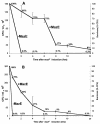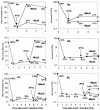MazF-mediated cell death in Escherichia coli: a point of no return
- PMID: 15576778
- PMCID: PMC532418
- DOI: 10.1128/JB.186.24.8295-8300.2004
MazF-mediated cell death in Escherichia coli: a point of no return
Abstract
mazEF is a stress-induced toxin-antitoxin module, located on the chromosome of Escherichia coli, that we have previously described to be responsible for programmed cell death in E. coli. mazF specifies a stable toxin, and mazE specifies a labile antitoxin. Recently, it was reported that inhibition of translation and cell growth by ectopic overexpression of the toxin MazF can be reversed by the action of the antitoxin MazE ectopically overexpressed at a later time. Based on these results, it was suggested that rather than inducing cell death, mazF induces a state of reversible bacteriostasis (K. Pederson, S. K. Christensen, and K. Gerdes, Mol. Microbiol. 45:501-510, 2002). Using a similar ectopic overexpression system, we show here that overexpression of MazE could reverse MazF lethality only over a short window of time. The size of that window depended on the nature of the medium in which MazF was overexpressed. Thus, we found "a point of no return," which occurred sooner in minimal M9 medium than it did in the rich Luria-Bertani medium. We also describe a state in which the effect of MazF on translation could be separated from its effect on cell death: MazE overproduction could completely reverse the inhibitory effect of MazF on translation, while not affecting the bacteriocidic effect of MazF at all. Our results reported here support our view that the mazEF module mediates cell death and is part of a programmed cell death network.
Figures



References
-
- Cherny, I., and E. Gazit. 2004. The YefM antitoxin defines a family of natively unfolded proteins: implications as a novel antibacterial target. J. Biol. Chem. 279:8252-8261. - PubMed
-
- Christensen, S. K., G. Maenhaut-Michel, N. Mine, S. Gottesman, K. Gerdes, and L. Van Melderen. 2004. Overproduction of the Lon protease triggers inhibition of translation in Escherichia coli: involvement of the YefM-YoeB toxin-antitoxin system. Mol. Microbiol. 51:1705-1717. - PubMed
Publication types
MeSH terms
Substances
LinkOut - more resources
Full Text Sources
Other Literature Sources

